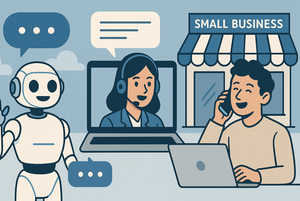How Chatbots Are Revolutionizing Customer Service for Small Businesses
Cuerpo
The Silent Shift in Customer Expectations
Small businesses have long struggled to compete with enterprise-level customer service. Limited budgets, staffing constraints, and technical gaps often force owners to choose between growth and quality support. But today, a quiet revolution is leveling the playing field: AI-powered chatbots.
Unlike the clunky, rule-based bots of the past, modern chatbots for small businesses leverage generative AI to deliver human-like interactions, automate workflows, and capture actionable insights—all without coding. For experts in the field, understanding how to harness these tools isn’t just optional; it’s critical to staying competitive.
Beyond FAQs: The Underutilized Capabilities of Chatbots
Most small businesses deploy chatbots to handle basic FAQs. But the real value lies in overlooked features that drive efficiency and revenue.
1. 24/7 Multilingual Support Without Hiring a Translation Team
A chatbot for small business can now converse fluently in 80+ languages, using real-time translation powered by large language models (LLMs). This isn’t just about answering questions—it’s about positioning your brand as a local entity in global markets. For instance, a boutique e-commerce store can serve Spanish-speaking customers without hiring bilingual staff, while a SaaS startup can qualify leads from Germany or Japan autonomously.
Practical Tip: Train your chatbot on localized content (e.g., regional pricing, cultural nuances) to avoid generic translations.
2. Automated Lead Generation and CRM Integration
Chatbots can qualify leads by asking context-aware questions and instantly logging details into CRMs like Zoho or HubSpot. Imagine a visitor asking about pricing: your chatbot can capture their email, segment them based on intent, and trigger a follow-up sequence—all before a human intervenes.
Practical Tip: Set up “if-then” rules to route high-intent leads (e.g., “interested in demo”) directly to sales teams.
3. Predictive Analytics Hidden in Chat Logs
Every interaction is a data goldmine. Advanced chatbots analyze conversation patterns to predict churn risks, upsell opportunities, and feature requests. For example, if 40% of users ask about a specific product limitation, that’s a roadmap signal.
Practical Tip: Track drop-off points in conversations. If users consistently abandon chats after asking about shipping costs, revisit your policy or UI.
Cost Efficiency: The Math You Haven’t Seen
The ROI of a chatbot for small business isn’t hypothetical. Consider:
- A 30% reduction in support costs by automating routine tickets (e.g., password resets, order tracking).
- A 400% increase in engagement when users get instant replies after hours.
- Eliminating $15,000+/year in live chat software fees by using an AI-first tool.
But the real savings come from preventing missed opportunities. A chatbot never sleeps, forgets to follow up, or misroutes a query.
Implementation Pitfalls to Avoid
Even the best chatbot fails without proper setup. Here’s how experts sidestep common mistakes:
1. Skipping Brand Personalization
Generic chatbots feel transactional. Customize yours with:
- Branded greetings (e.g., “Hi! I’m [Your Bot Name], here to help with skincare tips!”).
- Tailored response styles (friendly vs. formal).
- Colors and logos that align with your website.
2. Over-Automating Complex Scenarios
Chatbots excel at first-line support but struggle with nuanced issues. Use sentiment analysis to escalate frustrated customers to humans immediately.
3. Ignoring Continuous Training
Update your chatbot’s knowledge base quarterly. Add new product details, seasonal promotions, and revised policies to keep responses accurate.
The Future-Proof Advantage: Scalability
A well-built chatbot for small business grows with you. For example:
- Start by handling 50% of support tickets, then expand to lead nurturing.
- Integrate with new platforms (Slack, Messenger) as your channels diversify.
- Use A/B testing to refine conversation flows based on real user behavior.
Your Next Step: Choosing the Right Tool
Not all chatbots are equal. Look for:
- No-code builders to avoid developer dependency.
- Native integrations with your existing stack (website builders, CRMs).
- Multilingual LLMs trained on your content, not generic data.
One platform checking these boxes is sitebot. Designed for small businesses, it offers a no-code chatbot builder, 80+ language support, and CRM integrations—allowing you to deploy a tailored AI agent in minutes.
Ready to transform your customer service? Try sitebot’s 14-day free trial—no credit card required. Automate support, capture leads, and gain insights while your team focuses on what humans do best.










Comentarios